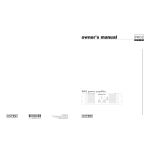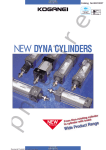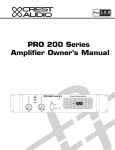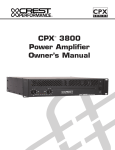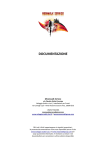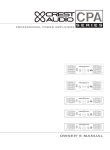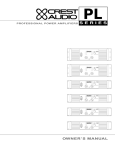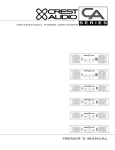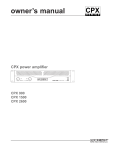Download Pro-Form 1000 LT Owner`s manual
Transcript
LT/ST Power Amplifier Owner’s Manual important precautions 1 Save the carton and packing materials! Should you ever need to ship the unit, use only the original factory packing. ¡ For replacement packaging, call Crest Audio’s Customer Service Department directly. 2 3 4 5 6 7 8 Do not parallel- or series-connect an amplifier output with any other amplifier output. Read all documentation before operating your equipment. Retain all documentation for future reference. Follow all instructions printed on unit chassis for proper operation. Never hold a power switch or circuit breaker in the on-position, if it won’t stay there by itself! Do not use the unit if the electrical power cord is frayed or broken. The power supply cords should be routed so that they are not likely to be walked on or pinched by items placed upon or against them. Always operate the unit with the AC ground wire connected to the electrical system ground. Precautions should be taken so that the means of grounding of a piece of equipment is not defeated. Crest Audio is not responsible for damage to loudspeakers for any reason. £ ¢ ˆ 0 Power down and disconnect units from mains voltage before making connections. Do not drive the inputs with a signal level greater than that required to enable equipment to reach full output. Do not connect the inputs or outputs of amplifiers to any other voltage source: such as a battery, mains source, or power supply, regardless of whether the amplifier is turned on or off. Connecting amplifier outputs to oscilloscopes or other test equipment while the amplifier is in bridged mono mode may damage both the amplifier and test equipment! Do not spill water or other liquids into or on the unit, or operate the unit while standing in liquid. Do not block fan intake or exhaust ports. Do not operate equipment on a surface or in an environment which may impede the normal flow of air around the unit: such as a bed, rug, weathersheet, carpet, or completely enclosed rack. § Never connect a hot (red) output to ground or to another hot (red) output! 9 Service Information Do not remove the cover! Removing the cover will expose you to potentially dangerous voltages.There are no user serviceable parts inside. Equipment should be serviced by qualified service personnel when: A. The power supply cord or the plug has been damaged. Ô Damage caused by connection to improper AC voltage is not covered by any warranty. Mains voltage must be correct and the same as that printed on the rear of the unit. Do not ground any hot (red) terminal. Do not run the output of any amplifier channel back into another channel’s input. If the unit is used in an extremely dusty or smoky environment: the unit should be periodically blown free of foreign matter. ¶ Do not use the unit near stoves, heat registers, radiators, or other heat producing devices. ƒ The power cord of equipment should be unplugged from the outlet when left unused for a long period of time. B. The equipment has been exposed to rain. C. The equipment does not appear to oper- ate normally,or exhibits a marked change in performance. D. The equipment has been dropped, or the enclosure damaged. To obtain service: contact your nearest Crest Audio Service Center, Distributor, Dealer, or Crest Audio at 201.909.8700 USA or visit www.crestaudio.com for additional information. email [email protected] This symbol is used to alert the operator to follow important procedures and precautions detailed in documentation. This symbol is used to warn operators that uninsulated “dangerous voltages” are present within the equipment enclosure that may pose a risk of electric shock. This equipment conforms to EN55022 Class A. In a domestic environment this product may cause radio interference in which case the user may be required to take adequate measures. This equipment has been tested and found to comply with the limits for a Class B digital device pursuant to part 15 of the FCC Rules.These limits are designed to provide reasonable protection against harmful interference in a residential installation.This equipment generates, uses and can radiate radio frequency energy and, if not installed and used in accordance with the instructions, may cause harmful interference to radio communications. However, there is no guarantee that interference will not occur in a particular installation. If this equipment does cause harmful interference to radio or television reception, which can be determined by turning the equipment off and on, the user is encouraged to try to correct the interference by one or more of the following measures: *Reorient or relocate the receiving antenna. *Increase the separation between the equipment and the receiver. *Connect the equipment into an outlet on a circuit different from that to which the receiver is connected. *Consult the dealer or an experienced radio/TV technician for help. table of contents to use this manual 1 how introduction p.2 p.3 2 installation unpacking p.5 mounting cooling and ventilation powering maintenance overview 3 features front panel p.9 rear panel operation modes 4 stereo p.15 contents parallel bridged 5 connections input p.17 output 6 safety tourclass protection p.21 precautions user responsibility service and support 7 support contact us p.25 registration a specifications p.27 b c block diagram p.28 wire gauge charts appendices p.29 p. 1 1 how to use this manual conventions terms official Crest Audio features and each indicator or control on the amplifier will appear as: terms actions specific actions or selections the user can execute will appear as: actions tasks are broken down into steps 1 2 3 warnings Procedures not to attempt. a Issues or hazards to keep in mind when operating the equipment. indicators What to look for on the equipment display. Alerts, indicators, or prompts that may appear. ® tips Preferred methods. Helpful hints. Feature insights. + see see—refers to other sections of the manual containing supplementary information on the current topic or a related issue note note—supplementary feature information p. 2 LT / ST owner’s manual introduction 1 welcome Congratulations on your purchase of a new LT / ST Series professional power amplifier and thank you for your confidence in Crest Audio products. You are among the growing number of audio professionals who have made Crest Audio one of the world’s leading suppliers of professional and commercial/industrial audio systems. For your safety, please read the Important Precautions section before installing and operating the amplifier.The Crest Audio LT and ST Series amplifiers are designed for high operating efficiency and accurate sonic performance across the full audio bandwidth, even under stressful conditions. The Crest Audio LT and ST series both utilize Class D amplifier technology which greatly improves the efficiency of the amplifier and reduces the power demand from the mains supply.The LT amplifier incorporates a linear power supply whereas the ST uses a resonant switching supply with power delivery characteristics similar to a linear supply but with greatly reduced weight. Both power supply designs are built to the same uncompromising standards. This, combined with major advances in amplifier technology provides for extreme reliability and sonic accuracy for which Crest products are renown. The Crest audio LT series and ST series amplifiers differ in power supply design, electrical efficiency and weight however, their feature sets are identical. For this reason, the majority of this users manual applies to both models. LT linear-toroid power supply A traditional linear power supply is used in the LT Series. Because of the amplifier sections efficiency, (approx 93%) the transformer does not need to be as big or as heavy.This gives the LT Series an advantage in delivering more power in a more compact package. The efficiency of the output stage also gives the power supply the ability to handle heavy-duty cycles without compromising sonic integrity. ST resonant-switching power supply The ST amplifier switching power supply employs a resonant design which utilizes zero-power switching technology. Benefits of resonant-switching include: • reduced power component stress for better reliability and efficiency • 20dB lower noise than conventional switching supplies (and therefore more EMC friendly) • behaves like a classic linear supply, but with the added advantages of size and weight reduction In order to maintain strict quality assurance standards, all Crest Audio power amplifiers are built in our state-of-theart USA manufacturing facility. Internal components are the finest available and key sub-assemblies are pre-tested before final assembly. Each amplifier is “burned in” and thoroughly tested (using precision audio test equipment) before shipping. In addition, all LT / ST Series amplifiers incorporate Crest’s exclusive TourClass® protection features to safeguard both internal circuitry and connected loudspeakers. This proven combination of advanced design,quality construction and comprehensive circuit protection is your guarantee of fail-safe reliability. You can depend on consistent, stable performance even when your LT / ST Series amplifier is subjected to punishing extremes in the most demanding fixed or mobile sound reinforcement applications. p. 3 installation 2 / what to do with the shipping carton / proper rack-mounting technique / keeping the amplifier cooled / required AC line voltages / routine maintenance practices unpacking mounting cooling and ventilation powering maintenance p. 5 2 installation LT / ST owner’s manual unpacking Please inspect the amplifier carefully immediately after unpacking. If you find any damage, notify your supplier/dealer immediately. Only the shipper may file a damage claim with the carrier for damage incurred during shipping. Be sure to save the carton and all packing materials for the carrier’s inspection. If the packing materials are in good condition, please save them. If you ever need to ship the unit anywhere without mounting it in a rack, you should take advantage of the original factory packing materials in order to avoid unnecessary damage. mounting All LT / ST Series amplifiers mount in standard 19-inch racks and occupy two rack spaces. Four front-panel mounting holes are provided on each amplifier. Rear mounting ears give additional support and use of rear supports is highly recommended in all mobile and touring sound systems. Handles are fitted standard. LT shown. ST has the same dimensions front height 3.47"/ 88 mm front width 19"/483mm LT / ST shown rear width 17"/432mm front height 3.47" / 88mm depth14"/356mm p. 6 For replacement packaging, call Crest Audio’s Customer Service Department directly. + see—service and support installation 2 cooling and ventilation LT / ST amplifiers use a forced air cooling system to maintain a low,even operating temperature. Air is drawn in by a DC fan on the rear panel, flows through the cooling fins and then exhausts through the front panel vent. Heat sink temperature is monitored and controls the variable speed fan. Fan speed increases only as required, keeping fan noise to a minimum. If the heat sink surpasses its maximum allowed temperature, the thermal protection circuit will activate and open the output relays allowing the amplifier to cool to a safe temperature. To continue using the amp, it must be reset by turning the power off and then turning it back on again. a Make certain that there is enough space around the front and rear of the amplifier to allow the heated air to escape. When mounting in a rack, try to avoid using doors or covers on the front and rear of the enclosure; the exhaust air must not be impeded suggestion In racks with closed backs allow at least one standard-rack-space opening for every four amps. Thermal protect activation only occurs under extreme thermal conditions and is not part of normal operation. powering Unless otherwise specified when ordered, LT / ST amplifiers are supplied factory set to following voltage options : Option 1 US domestic nominal 120Vac 60Hz for rated power output (safe operating range 100 - 132Vac ) Option 2 export models nominal 230Vac 50Hz for rated power output (safe operating range 200 - 264Vac ) note Due to the nature of the switching power supply in the ST, 50 - 60Hz operation is acceptable for both options. maintenance LT / ST amplifiers require no routine maintenance. If the amplifier is used in an extremely dusty or smoky environment , the unit should be periodically blown free ( using compressed air ) of any foreign matter that may have built up inside the unit. Users will not need to make any adjustments to the amplifier during its lifetime.There are no user-serviceable parts or adjustments that require opening the amplifier. p. 7 features overview 3 / location of connectors and controls / legend of panel symbols front panel rear panel p. 9 3 features overview LT / ST owner’s manual LT / ST shown p. 10 1 2 3456 7 8 9 1 2 3456 7 8 9 features overview 3 front panel 1 Rack Mounting Ears Two front-panel mounting holes are provided on each mounting ear. 2 Channel Level attenuators Two input attenuators adjust level for their respective amplifier channels. In Bridged Mono and Parallel modes, the channel A attenuator controls overall signal level (see rear panel mode switch description). 3 Protect This Red LED indicates that the amp channel is in Protect mode. During Power up, the amp briefly goes into protect mode in order to prevent any loud spikes from being fed the speakers. After a few seconds the amp comes out of protect mode and is ready for normal operation. If the amp stays in Protect mode, this indicates that there may be a problem internal to the amp. If the amp goes into Protect mode during operation this indicates that either a problem has developed internal to the amp or the amp is being over-stressed and needs to cool down. After a Protect condition, the amp must be reset by cycling the power off and then on again in order to continue using it. 4 ACL / IGM This Red LED illuminates when either the ACL or IGM protection circuitry is engaged. See Section 6,Tourclass Protection for more information on these Crest-exclusive features. 5 -24, -18, -6, 0dB The first three LEDs (-24, -18, -6,) are Green and the last led, 0dB is yellow. These LEDs respond to the incoming program material as peak meters. Under normal operating conditions the Green LEDs illuminate with the dynamics of the program material and the Yellow LED flashes during the loudest peaks. 6 Signal Green LED varies in intensity in response to signals below -24 dB. 7 Active Green LED illuminates when the amp is on to show that the channel is active. 8 Fan Outlet Grill LT & ST Series amplifiers are cooled by a single rear-mounted fan. Cool air flows over the heat sink and exhausts through the front grill. Make sure this outlet remains clear to allow unrestricted airflow. 9 Power switch This switch turns the amp on and off. If the amp doesn’t turn on when the switch is in the ON position, check the circuit breaker on the rear panel. p. 11 LT / ST shown 2 3 4 1 6 5 7 rear panel legend rear panel 1 IEC power connector Accepts a standard IEC terminated power cable 2 Breaker Resettable circuit breaker - no fuses are used. Breaker can trip due to a power surge or over-voltage condition. If it trips once, reset it. If it continues to trip, the amplifier may need servicing. input connection XLR connector polarity TRS connector polarity bridged mono mode parallel mode stereo mode 3 Fan The fan operates continuously while the amp is on. An internal temperature sensor increases the speed of the fan during high temperature conditions. Air enters through the rear of the amp and exits through the front grill. Be sure to allow adequate air flow from the rear of the rack the amp is mounted in. chassis ground lifted-position chassis ground grounded-position output connection speakon output channel A stereo/parallel channel B stereo/parallel bridged mono five-way binding post channel A stereo/parallel bridged mono channel B stereo/parallel p. 12 features overview 3 rear panel 4 Output connections Speakers can be connected via the high current binding posts and the industry-standard Speakon (NL-4) connectors. Binding posts: One pair (Red- hot, Black- ground) per channel. Speakons - One connector for each channel. In Bridged Mono mode, the Speakon connector for Channel A is used exclusively (see Operation Modes). 5 Ground lift switch The recessed two-position ground lift switch is used to isolate the amp’s signal ground from the chassis/AC ground.The factory default setting is to the right, Grounded.To lift, or disconnect the signal ground from the chassis/AC ground, slide the switch to the left. In situations where chassis ground must be lifted, use this switch never lift the ground prong on the AC connector. 6 Input connections Input signals can be connected to the amp via the Phoenix connectors, the 1/4” TRS connectors and the Female XLR (pin 2 hot) connectors. Input sensitivity is .775v (0 dBv) for full rated output power. See Connections 7 Mode selector switch This recessed, three position switch configures the amplifier for Stereo, Parallel or Bridged Mono operation. The default factory setting is Stereo. See - operation modes. Never connect a hot (red) output to ground or to another hot (red) output! a In situations where an UNBALANCED signal is fed to the amp, it’s important to ground the unused input. If the inverting (-) input of an amp channel is left floating, the channels gain will drop by 6 dB. In effect, the amp will not be as loud. For more information about this, ask your dealer or contact Crest Audio Technical Support directly. a a Do not adjust the mode selection switch while the amplifier is turned-on. p. 13 operation modes / choosing the appropriate mode / switching between operation modes / special considerations when using bridged mode 4 stereo parallel bridged p. 15 4 operation modes LT / ST owner’s manual mode selection The three-position, recessed Mode Select switch (located on the rear panel) configures the amplifier for Stereo, Parallel or Bridged mode. Amplifiers are factory-configured for Stereo mode. Shut the amp off before changing modes. stereo In Stereo mode, both channels operate independently, with their input attenuators controlling their respective levels.Signal at Channel A’s input produces output at Channel A’s output,while signal at Channel B’s input produces output at Channel B’s output.Recommended minimum nominal load impedance for stereo operation is 2 Ohms per channel. parallel When set to Parallel mode, program material applied to Channel A’s input will appear at both Channel A and B outputs.The attenuator for Channel A controls the level for both A and B outputs. bridged Bridged mode straps both amplifier channels together to make a singlechannel monaural amplifier. One channel pushes and the other pulls equally, increasing the power output over that of either channel alone (see Specifications). Signal is applied to the Channel A input only. Channel A’s attenuator is used to control signal level. Use extreme caution when operating the amplifier in Bridged mode. Never ground either side of the speaker cable when the amplifier is in Bridged mode; both sides are “hot.” If an output patch panel is used, all connections must be isolated from each other and from the panel.The recommended minimum nominal load impedance in the Bridged mode is 4 ohms, which is the equivalent to driving both channels separately at 2 ohms. see—connections for examples of mode-specific wirings p. 16 a Connecting amplifier outputs to oscilloscopes or other test equipment while the amplifier is in bridged mode may damage both the amplifier and test equipment! connections 5 / / proper wiring schemes for connectors: speakon binding post input correct signal paths: stereo, parallel and bridged output XLR 1/4” TRS Phoenix 3 pin p. 17 5 connections LT / ST owner’s manual inputs LT / ST amplifiers are configured standard with pin 2 hot on XLR inputs. female XLR TRS pinouts 3-pin Phoenix (view of connector on rear of amp) In + In - Com outputs Speakers are connected using the high-current five-way binding posts or speakon connectors, or both. stereo/parallel Speaker + to PIN 1+ Speaker - to PIN 1see—operation modes p. 18 bridged mono Speaker + to PIN 1+ Speaker - to PIN 2+ a Very high current is available at the outputs. Please connect your output cable to the + and - terminals of each section precisely as shown. connections 5 stereo mode five-way binding post connectors parallel mode five-way binding post connectors bridged mono mode five-way binding post connectors p. 19 5 connections stereo mode speakon output connectors parallel mode speakon output connectors bridged mono mode speakon output connectors Speaker + to PIN 1+ Speaker - to PIN 2+ p. 20 LT / ST owner’s manual safety / the owner’s role in amplifier safety / protecting your speakers / description of TourClass protection features 6 user responsibility speaker protection TourClass p. 21 6 safety LT / ST owner’s manual user responsibility Your LT / ST Series amplifier is very powerful and can be potentially dangerous to loudspeakers and operators alike. It is your responsibility to read important precautions (see the inside-front cover) and make sure that the amplifier is installed, wired, and operated properly as instructed in this manual. Many loudspeakers can be easily damaged or destroyed by overpowering, especially with the high power available from a bridged amplifier. Always be aware of the speaker’s continuous and peak power capabilities. Crest Audio is not responsible for damage to loudspeakers for any reason. see—speaker protection speaker protection All loudspeakers have electrical, thermal and physical limits which must be observed to prevent damage or failure.Cone or compression drivers can be damaged (sometimes to the point of failure) from excessive power, low frequencies applied to high frequency drivers, severely clipped wave forms,and DC voltage. All LT / ST Series amplifiers automatically protect speakers from DC voltages and subsonic signals. see—TourClass protection Mid- and high-frequency transducers—compression drivers in particular—are highly susceptible to damage from overpowering, clipped wave forms, or frequencies below their rated pass band.When using an electronic crossover, make absolutely certain that the low and mid bands are connected to the correct amplifiers and drivers—and not accidentally connected to those for a higher or lower frequency band. The amplifier’s clipping point is its maximum peak output power. At maximum peak output power,Crest Audio LT / ST Series amplifiers will deliver more power than many speakers can safely handle. Be sure the peak power capability of the amplifier is not excessive for your speaker system.To ensure that the speakers never receive excessive power, and to prevent amplifier clipping,use a properly adjusted external limiter (or a compressor with a ratio of 10:1 or higher) to control power output. Use one compressor/limiter for each frequency band in systems with active electronic crossovers. The ACL clip limiting circuit will automatically limit the duration of squared-off, continuous wave forms applied to the speakers.The amplifier will, however, allow normal musical transient bursts to pass. Of course, when the amplifier does clip, it is operating at its maximum output power.Note that some speaker systems are packaged with proprietary “processors” that have power limiting circuits and therefore should not require additional limiting. Do not drive any low-frequency speaker enclosure with frequencies lower than its own tuned frequency; the reduced acoustical damping could cause a ported speaker to bottom out even at moderate power.Consult the speaker system specifications to determine its frequency limits,and employ a roll-off filter if necessary. recommended speaker cabling The wire gauge charts will assist you in determining the optimum copper wire gauge for your speaker cables.Remember that the speaker cable resistance robs amplifier power in two ways: through power lost directly to resistance (often referred to as I2R loss), and through increased total load resistance, which decreases the amount of power available from the amplifier. Appendix C gives cable length figures in feet/AWG wire gauges and in metric values. see—wire gauge p. 22 safety 6 TourClass protection ® Just like Crest Audio’s highly acclaimed Pro series amps, LT and ST amps incorporate TourClass protection features. Derived from Crest Audio’s extensive experience with the world’s largest sound rental companies, the TourClass group of circuits sets the industry standard for assured protection of internal amplifier circuits and all connected loads. ACL ACTIVE CLIP LIMITING At the amplifier’s full power limit, or clipping point, ACL will be activated.This is indicated by illumination of the ACL / IGM LED.The channel gain is automatically reduced, protecting the loudspeakers from potential damage from the high power, continuous square waves that would otherwise be produced. ACL may be activated by uncontrolled feedback, oscillations, improper equipment gain settings, or an equipment malfunction upstream from the amplifier. Only steady or excessive clipping (not normal program transients) will trigger ACL. The circuit is virtually transparent in operation and full signal bandwidth is maintained. IGM INSTANTANEOUS GAIN MODULATION IGM is an innovative circuit that allows the amplifier to operate safely into loads as low as 2 ohms.When the amplifier sees a load that overstresses the output stage,the IGM circuit adjusts the channel gain to a safe level. This gain control circuit is inaudible in normal use. In addition, if extreme and sustained low impedance is encountered, the amplifier’s output relay will open. AutoRamp Auto Ramp operates every time the amplifier is turned on or is reactivated after a protect condition is corrected.This exclusive Crest Audio feature gradually increases gain to the attenuator setting avoiding unnecessary stress on the loudspeakers. Thermal Protect Abnormally high heat sink temperatures will engage the Protect circuit and disconnects the output relays. During this time the Prot LEDs will light red.The cooling fan will continue running at high speed. Normal operation resumes once the amplifier cools to a safe level. Short Circuit If an output is shorted (i.e. defective speakers or crossed speaker wires) the channel will shutdown and can be re-set by turning the amplifier off, then on. DC Voltage If an amplifier channel detects DC voltage at its output terminals, the output relay will immediately open to prevent loudspeaker damage. The protect LEDs illuminate. Subsonic Frequencies Built-in high pass filtering provides subsonic frequency protection for each channel. In addition, a relay will open if excessive subsonic energy appears at the output. p. 23 service and support / when to get support / ways to contact Crest Audio 7 support contact us p. 25 7 service and support LT / ST owner’s manual support In the unlikely event that your amplifier develops a problem, it must be returned to an authorized distributor, service center or shipped directly to our factory. To obtain service, contact your nearest Crest Audio Service Center, Distributor, Dealer, or any of the worldwide Crest Audio offices. For those with Internet access, please visit the Crest Audio web site. contact us customer service phone 201.909.8700 USA fax 201.909.8744 USA email [email protected] technical support phone 201.909.8700 USA fax 201.587.0550 USA email [email protected] web site www.crestaudio.com mail Crest Audio Inc. 16-00 Pollitt Drive Fair Lawn, NJ 07410 USA p. 26 + For replacement packaging, call Crest Audio’s Customer Service specifications a LT / ST 1kHZ, 0.5%THD+N 1000 1500 2000 Stereo power 8Ω 280W 400W 550W 4Ω 500W 750W 1000W 2Ω 650W 900W 1200W Bridged mono power 8Ω 1000W 1500W 2000W 4Ω 1300W 1800W 2400W Maximum output voltage rms each channel 53 rms 64 rms 72 rms Frequency response 1W @ 8Ω 20Hz–20kHz, +0 / - 1dB 20Hz–20kHz, +0 / - 1dB 20Hz–20kHz, +0 / - 1dB Power bandwidth @ rated power 20Hz–20kHz, +0 / - 1dB 20Hz–20kHz, +0 / - 1dB 20Hz–20kHz, +0 / - 1dB 400:1 @ 8Ω 400:1 @ 8Ω, 400:1 @ 8Ω, Damping Factor Input cmrr Input sensitivity for full rated output power Input impedance 60dB @ 1 kHz 60dB @ 1 kHz 60dB @ 1 kHz .775V .775V .775V 20K balanced 10K unbalanced 20K balanced 10K unbalanced 20K balanced 10K unbalanced Hum and noise -100dB, A-weighted below rated power -100dB, A-weighted below rated power -100dB, A-weighted below rated power Crosstalk -55dB @ 1kHz below rated power -55dB @ 1kHz below rated power -55dB @ 1kHz below rated power D D D Class Circuit breaker rating 120Vac 10A 15A 20A Circuit breaker rating 230Vac 6A 10A 12A Current draw 1/8 power, 4Ω 120Vac 3A 4A 5A Current draw 1/3 power, 4Ω 120Vac 6A 8.5A 10A Current draw idle 120Vac 0.6A 0.6A 0.6A Thermal emissions 1/3 Power, 4Ω, BTU/HR 1240 1630 1960 Back to front via variable speed fan Back to front via variable speed fan Back to front via variable speed fan Female XLR pin 2+, stereo 1/4” TRS jack socket, 3 pin Phoenix Combicon Female XLR pin 2+, stereo 1/4” TRS jack socket, 3 pin Phoenix Combicon Female XLR pin 2+, stereo 1/4” TRS jack socket, 3 pin Phoenix Combicon Speakon connectors and 5 way binding post Speakon connectors and 5 way binding post Speakon connectors and 5 way binding post Cooling Input connectors, per channel Output connectors Controls LED indicators TourClass protection Construction Front panel: two attenuators power switch. Rear panel: signal ground-lift, mode select thermal circuit breaker (all models) ACL, IGM, protection 5 segment bargraph VU meter, active AUTORAMP ACL, IGM, protection ACL, IGM, protection 5 segment bargraph VU meter, active AUTORAMP 5 segment bargraph VU meter, active AUTORAMP ACL, IGM, AUTORAMP. SHORT CIRCUIT ACL, IGM, AUTORAMP. SHORT CIRCUIT ACL, IGM, AUTORAMP. SHORT CIRCUIT DC VOLTAGE TURN ON/OFF TRANSIENT DC VOLTAGE TURN ON/OFF TRANSIENT DC VOLTAGE TURN ON/OFF TRANSIENT CURRENT IN-RUSH, SUB CURRENT IN-RUSH, SUB / ULTRASONIC INPUT / ULTRASONIC INPUT CURRENT IN-RUSH, SUB / 16 gauge steel chassis 16 gauge steel chassis 16 gauge steel chassis Dimensions 3.5” x 19” x 15.25” 89mm x 483 x 388mm height x width x depth Weight net LT 30lb 32.5lb 35lb 22.5lb 23lb 23lb net ST ULTRASONIC INPUT p. 27 b block diagram LT / ST owner’s manual Channel A Inputs Channel A Outputs Phoenix Combicon 5-Way Binding Posts Neutrik Speakon A ATTENUATOR 1/4” TRS 1 Female 3-Pin XLR 3 OUTPUT RELAY OUTPUT STAGE 2 Channel B Inputs Channel B Outputs Phoenix Combicon 5-Way Binding Posts Neutrik Speakon B ATTENUATOR 1/4” TRS C B A 1 3 Female 3-Pin XLR 2 p. 28 MODE SWITCH A: STEREO B: PARALLEL C: BRIDGE OUTPUT RELAY OUTPUT STAGE SEE SECTION 5 FOR OUTPUT CONNECTION DETAILS wire gauge c stranded cable length 2 5 wire gauge meters meters 10 meters 30 power loss 0.3mm2 8 Ω load 2.9% 4 Ω load 0.5 1.74 3.4 6.7 0.75 1.16 2.3 4.5 1.5 0.58 1.16 2.3 2.5 0.35 0.70 1.39 4.0 0.22 0.44 0.87 0.5mm2 4.3% 8.2% 15.5% 0.75 2.9 5.6 10.8 1.5 1.45 2.9 5.6 2.5 0.87 1.74 3.4 4 0.55 1.09 2.2 6 0.37 0.73 1.45 0.5mm2 8.24% 5.5% 28% 0.75 5.6 10.8 19.9 1.5 2.9 5.6 10.8 2.5 1.74 2.9 6.7 4 1.09 1.74 4.3 6 0.73 1.09 2.9 15.5% 0.73% 45% 1.5 8.2 15.5 28 2.5 5.1 9.8 18.2 4 3.2 6.3 12.0 6 2.2 4.3 8.2 10 1.31 2.6 5.1 meters 0.75mm2 5.6% 2 Ω load 10.8% p. 29 c wire gauge stranded cable length 5 wire gauge feet 10 feet 40 80 p. 30 LT / ST owner’s manual feet feet power loss 8 Ω load 4 Ω load 2 Ω load 18 AWG 0.81% 1.61% 3.2% 16 0.51 1.02 2.0 14 0.32 0.64 1.28 12 0.20 0.40 0.80 10 0.128 0.25 0.51 18 AWG 1.61% 3.2% 6.2% 16 1.02 2.0 4.0 14 0.64 1.28 2.5 12 0.40 0.80 1.60 10 0.25 0.51 1.01 18 AWG 6.2% 11.9% 22% 16 4.0 7.7 14.6 14 2.5 5.0 9.6 12 1.60 3.2 6.2 10 1.01 2.0 4.0 8 0.60 1.20 2.4 18 AWG 11.9% 22% 37% 16 7.7 14.6 26 14 5.0 9.6 17.8 12 3.2 6.2 11.8 10 2.0 4.0 7.7 8 1.20 2.4 4.7 http://www.crestaudio.com LT/ST Owner's Manual Version 1.3 03/21/02



































